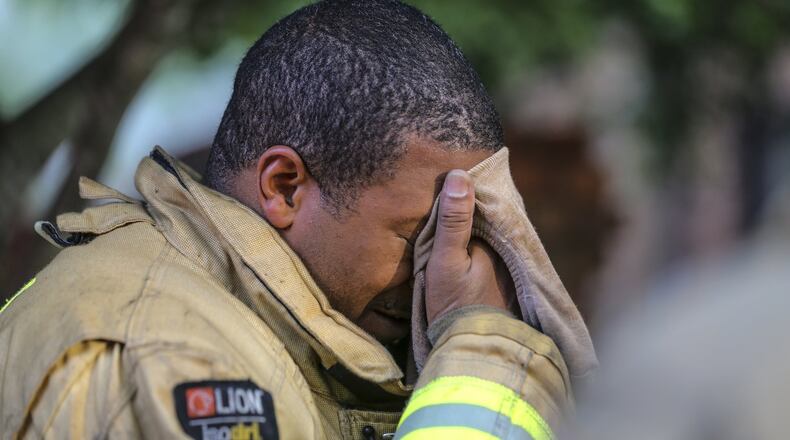Over the next few weeks as spring turns to summer, metro Atlanta can expect above-normal temperatures and above-normal rainfall. In the fight against COVID-19, some experts are hoping the heat and humidity that draw complaints from locals may prove beneficial. Several preliminary studies suggest that higher temperatures in spring and summer may bring a slowdown to the pandemic that has sickened thousands of Georgians.
» COMPLETE COVERAGE: Coronavirus in Georgia
» RELATED: As hospitals fight to keep up, they tell mild cases not to seek tests
With experts around the world still racing to understand the behavior of COVID-19, it is too soon to draw definitive conclusions about how the virus will respond to warmer weather. However, statistical studies have shown that the seasonality of COVID-19 could be consistent with the seasonality of other infectious diseases, including influenza, which peaks between December and February but can run through May.
“As the temperature increases … that drops the vitality of the virus, not only in the air but also on environmental surfaces. That is well known. There is no reason why it shouldn’t be the same (for COVID-19),” said Dr. Jose A. Vazquez, chief, Division of Infectious Diseases, and professor for the Medical College of Georgia at Augusta University. “Will we see a lower level of infection during the summer? We probably will. I think we will flatten the curve a lot more quickly than the North.”
But already the new coronavirus has displayed behaviors unlike some other viral respiratory infections, such as its capability for asymptomatic transmission. That, along with several factors that aren’t addressed by the current studies, is enough to give some experts pause before declaring a summer slowdown in the spread of COVID-19.
» REPORT: CDC expected to recommend face masks in wake of coronavirus pandemic
“We know that the virus does not survive well on surfaces at higher temperatures,” said Dr. Carlos del Rio, executive associate dean for Emory at Grady and professor of infectious diseases, epidemiology and global health at Emory University. “We don’t know if higher temperatures will impact transmission.”
In the White House virtual town hall on March 24, Dr. Deborah Birx, White House coronavirus response coordinator, said COVID-19 could have seasonality. A lower transmission rate during the summer months would give health researchers time to continue work on treatments and vaccines in anticipation of its possible return in the fall, she said.
» READ MORE: Georgia companies race to treat COVID-19
A recent analysis from two researchers at MIT, which had similar findings as a previous study from the University of Maryland School of Medicine, found the most new cases of COVID-19 in regions with a low mean temperature between 37.4 and 62.6 degrees Fahrenheit (3 to 17 degrees Celsius).
That could be good news for Georgia and the Southeast, but not for the northern parts of the U.S. where the heat and humidity only reach optimal levels for about two months. “Our analysis shows that the chances of reduced spreading due to environmental factors would be limited across most of northern Europe and North America in summer,” wrote the co-authors, Qasim Bukhari and Yusuf Jameel.
Temperatures in Georgia have been on the rise throughout March with a handful of days reaching above 80 degrees, based on Accuweather historical data. There is an 83% chance that average temperatures during the three months from April to June will be above 68.5 degrees, according to the National Weather Service in Peachtree City.
“My hope is that when May rolls around, we will start getting some periods of prolonged warmth,” said state climatologist Bill Murphey. Georgia is also experiencing a period of above-normal rainfall — this year has been the fourth-wettest year on record, Murphey said. Rain can increase relative humidity as more water is continuously drawn into the air.
Bukhari and Jameel noted that while the relation between the number of COVID-19 cases and temperature and humidity was observed to be strong, the reasons are unclear.
» DASHBOARD: Real-time stats and charts of coronavirus in Georgia
It may be harder for the virus to survive in higher temperatures or it may be harder for the virus to stay airborne in higher humidity. Either factor, temperature or humidity, could be more important, equally important or not important at all. And a number of non-weather-related factors may have had an impact on the number of cases recorded in different countries, such as the amount of testing, social distancing practices and travel restrictions.
The authors noted the importance of continuing to take precautions against COVID-19 and said laboratory testing was needed to further understand these associations.
Dr. Jeffrey Shaman, epidemiologist and head of the Climate and Health Program at Columbia University, said he would like to see experiments that focus on how long the virus can survive, both airborne and on surfaces, at varying levels of temperature and humidity to measure the virus’s sensitivity to those specific weather conditions.
Some tests are already underway. Physicists at the University of Utah in March received a grant from the National Science Foundation to study the structure of COVID-19 and understand how it responds to changes in humidity and temperature. The study uses a replica of the virus to examine the level of infectivity in different weather conditions.
“People are tantalized by the possibility that maybe this virus may have a similar process (as influenza) affecting it and come May or June we will see a reduction in the transmissibility of the virus and it may even disappear,” said Shaman. “We just don’t know at this point, and planning on that is not what you want to do. You need to plan for the condition that it is not seasonal and it will keep barreling through the summer.”
About the Author
The Latest
Featured




